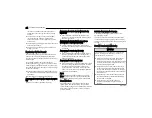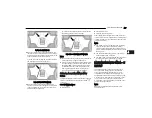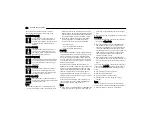
WARNING!
●
Maintain a safe distance from other vehicles and
pay attention to traffic conditions.
●
Do not use a hand held device when either
Base, or Hands-Free Active Driving Assist system
is engaged.
●
Always pay attention to the road when the Hands-
Free Active Driving Assist system is engaged. The
Active Driving Assist system will not steer to avoid
safety hazards, construction zones, objects, or
road impediments. You need to take control to
steer and brake the vehicle in such situations,
and when merging into traffic, exiting the highway,
making a turn for crossing traffic, or stopping for
traffic control devices.
●
Do not place any objects on the steering wheel
(e.g. steering wheel covers) which could interfere
with the hand detection sensors.
The Hands-Free Active Driving Assist system DOES NOT:
●
Warn or prevent collisions with other vehicles
●
Steer your vehicle around stopped vehicles,
slower vehicles, construction zones or equipment,
pedestrians, or animals
●
Respond to traffic lights or stop signs
●
Merge onto highways or exit off ramps
●
Change lanes in Hands-On mode
●
React to cross traffic
NOTE:
Adaptive Cruise Control (ACC) is a core component of
ADA. For ACC system limitations
The Active Driving Assist system may have limited
or reduced functionality when one of the following
conditions occur:
●
The vehicle’s radar sensors and/or forward facing
camera is damaged, covered, misaligned, or
obstructed (e.g. by mud, ice, snow, etc.)
●
If the suspension alignment is not correct, if the
vehicle is modified (e.g. lifting or lowering the
suspension, installing different sized wheels or tires)
or if there has been damage due to road hazards
●
Driving near highway toll booths
NOTE:
If damage to the windshield occurs, have the windshield
replaced by an authorized dealer as soon as possible.
ACTIVE LANE MANAGEMENT SYSTEM — IF
EQUIPPED
A
CTIVE
L
ANE
M
ANAGEMENT
O
PERATION
The Active Lane Management (ALM) system uses a
forward facing camera to detect lane markings or road
edges and to measure vehicle position within the lane
boundaries. It also uses the Blind Spot Monitoring
(BSM) sensors to detect vehicles in adjacent lanes
while the driver is preparing to change lanes.
The system is operational at speeds above 37 mph (60
km/h) and below 112 mph (180 km/h).
When both lane markings are detected, and the vehicle
approaches (or crosses) the lane marking with no turn
signal applied, and the blind spot zone is not occupied,
the ALM system provides warnings to prompt the driver
to remain within the lane boundaries. These warnings
include a visual warning in the instrument cluster along
with steering assist torque (if configured in Uconnect
Settings).
If the driver crosses the lane marking, the system
will either guide the vehicle back to the center of the
lane, provide a vibration in the steering wheel, or both,
depending on radio settings.
When both lane markings are detected, and the driver
uses the turn signal to indicate a lane change, and
a vehicle is detected in the BSM zone on that side
of the vehicle, the ALM system provides a warning in
the form of steering assist and/or steering vibration
(depending on radio settings) to guide the vehicle back
to the center of the lane.
NOTE:
●
The system will suppress visual warnings, steering
vibration (if selected in radio settings), and steering
assistance (if selected in radio settings) when the
driver activates the turn signal, the blind spot zone is
clear of vehicles, and a lane change is occurring.
●
If the Blind Spot Monitoring (BSM) system detects a
vehicle in the adjacent lane, and the turn signal is
applied in that direction, the BSM LED on the mirror
will flash. If the driver continues to attempt the lane
change, steering wheel torque will be provided to
keep the vehicle within its lane markings.
The driver may manually override the steering assist
warning by applying force to the steering wheel at any
time.
When only a single lane marking is detected and the
driver drifts across the lane marking (no turn signal
applied), the Active Lane Management system provides
STARTING AND OPERATING 175
4


































